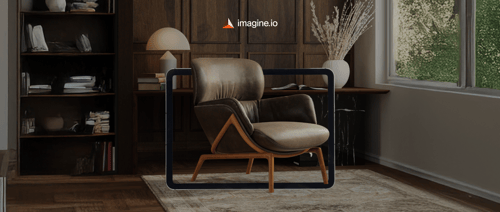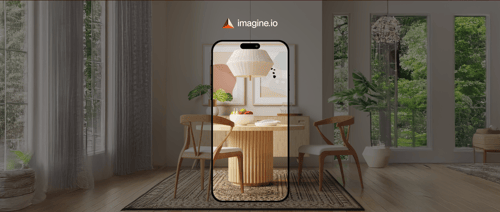In today’s digitally-driven retail landscape, one thing is clear—online shopping is here to stay. But even as eCommerce has transformed how consumers browse and buy, a critical gap has remained: the inability to experience products before purchase.
That’s where Augmented Reality (AR) steps in—redefining buyer confidence, customer satisfaction, and conversion rates across industries. With AR, the question “Will this work for me?” gets answered in real-time, on the customer’s terms.
Let’s break down how AR is quietly becoming a non-negotiable in the modern online shopping experience—and how platforms like imagine.io are making it more accessible than ever.
Get the latest updates straight to your inbox.
By clicking sign up you'll receive occasional emails from imagine.io. You always have the choice to unsubscribe within every email you receive.
See It to Believe It: How AR Solves the Visualization Gap
Picture this: You’re shopping for a new sofa online. You’ve filtered by size, style, and color. But then the doubt creeps in—Will it actually look good in my space? That uncertainty is what AR is solving for.
“Place in Room” AR features allow shoppers to overlay 3D models of furniture or home décor products into their actual living spaces using just a smartphone camera.
This isn’t just flashy tech—it’s a proven sales tool:
- Boosts buyer confidence: When customers see how a product fits into their environment, they’re more likely to commit.
- Reduces returns: According to recent studies, AR implementation can slash product return rates by up to 40%—a huge cost-saving for retailers.
- Shortens the decision-making cycle: Visual clarity often leads to faster purchases and fewer abandoned carts.
In categories like furniture, home appliances, and large-scale electronics, this level of visualization is no longer a “nice-to-have”—it’s expected.
Virtual Try-Ons: From Browsing to Belonging
AR isn’t just for big-ticket items—it’s also transforming beauty and fashion. Top brands like Sephora, Warby Parker, and Gucci are pioneering virtual try-ons that let users experiment with makeup, glasses, or accessories in real time. The result? More engaged shoppers and more confident purchases.
With imagine.io, retailers can build these interactive experiences without long development cycles or heavy investments. Instead of static product pages, you get dynamic try-on experiences that:
- Increase time-on-site: Users engage longer when they can play with products.
- Enhance personalization: Whether it’s trying lipstick shades on different skin tones or previewing eyeglasses on your face shape, AR adapts to individual users.
- Encourage social sharing: Shoppers love sharing their virtual try-ons, which organically expands reach and boosts brand visibility.
For retailers, this translates to higher conversion rates. Take Avon, for example: after integrating AR try-ons, they saw a 320% lift in conversions. That’s not just impressive—it’s game-changing.
Results That Speak for Themselves
AR isn't about bells and whistles anymore. It's about delivering measurable business outcomes. Brands that invest in AR are seeing results across key metrics:
|
Impact Area |
With AR |
|
Conversion Rate |
↑ Up to 300% |
|
Return Rate |
↓ Reduced by up to 30% |
|
Time Spent on Product Page |
↑ 2x to 5x longer |
|
Customer Satisfaction |
↑ Enhanced confidence in buying |
When businesses integrate 3D and AR technology, they create a seamless pipeline from product visualization to purchase, with less friction and more buyer confidence.
Why This Matters for B2B Retail Decision Makers
If you’re leading eCommerce, digital transformation, or marketing initiatives at your organization, you’ve likely seen the pressure to evolve the online buying experience. Your customers expect:
- Personalized Shopping Journeys: AR enables customers to tailor views to their environment, eliminating guesswork.
- Faster Decision-Making: Visual context accelerates the path to purchase.
- Greater Post-Purchase Satisfaction: By “trying” products virtually, buyers are more satisfied with their choices—resulting in fewer returns and better reviews.
And this isn’t just about the end consumer. Internally, AR-supported product content streamlines collaboration between merchandising, marketing, and design teams—especially when paired with a visual content creation hub like imagine.io.
Getting Started Doesn’t Require a Tech Army
One of the biggest misconceptions about AR is that it’s expensive and difficult to implement. With imagine.io, that’s simply not the case. We’ve built an all-in-one platform where teams can:
- Generate high-quality 3D visuals from simple product images or CAD files.
- Add AR functionality and embed it directly into their eCommerce site.
- Customize content at scale, whether it’s for one product or a thousand.
So whether you're selling sofas or sneakers, imagine.io helps you meet your customers where they are—in their homes, on their phones, and ready to buy.
Conclusion: The Future is Augmented—and It’s Already Here
Augmented Reality is no longer futuristic. It's functional, accessible, and proving its worth in real business results. For brands, it’s not just a way to impress customers—it’s a way to understand them better, serve them faster, and sell smarter.
Whether you’re looking to enhance product discovery, improve customer engagement, or drive more confident purchases, AR is your competitive edge.
Ready to see what it can do for your brand? Book a Free Demo with imagine.io .
Let us show you how easy it is to integrate 3D and AR into your digital strategy. Because when your customers can try before they buy, everybody wins.


.gif?width=1296&height=1296&name=Untitled%20design%20(8).gif)




.png?width=500&name=How%20to%20Add%20a%203D%20Product%20Configurator%20to%20Your%20WordPress%20Website%20(Complete%20B2B%20Guide).png)
















%20(1).png?width=500&name=Why%20Exploded%20Mattress%20Views%20Matter%20(And%20How%20to%20Generate%20Them)%20(1).png)
.png?width=500&name=Best%20Shopify%20Product%20Configurator_%20How%20to%20Choose%20the%20Right%20One%20(2).png)
.png?width=500&name=Why%20Exploded%20Mattress%20Views%20Matter%20(And%20How%20to%20Generate%20Them).png)



.png?width=500&name=Best%20Shopify%20Product%20Configurator_%20How%20to%20Choose%20the%20Right%20One%20(1).png)







.png?width=500&name=How%203D%20Rendering%20Can%20Make%20or%20Break%20Your%20Industrial%20Design%20Pitch%20(1).png)








%20with%20Digital%20Twins%20and%203D%20Visualization.png?width=500&name=Optimizing%20Your%20Digital%20Asset%20Management%20(DAM)%20with%20Digital%20Twins%20and%203D%20Visualization.png)




.png?width=500&name=Styling%20Home%20Decor%20for%202025_%20From%20Global%20Influences%20to%20Playful%20Personalization%20(1).png)
